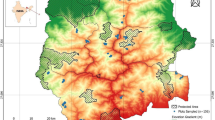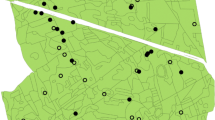Abstract
Frequent burning and grazing and cultivation of cash crops increasingly threaten forest patches in hilly grassland in Northeast Luzon, yet their importance as a resource with multiple environmental functions and forest products persists. The aim of this study is to identify different types of forest patches, and their condition under present land-use intensification, and discuss prospects for their integration into sustainable local farming systems. Five types of forest patches are distinguished, both natural and planted ones, including rows of trees, woody patches, gallery forests, hill-slope forests and homegarden conglomerations. Natural woody patches and gallery forests in Imperata grassland are subject to degradation and land-use conversion under conditions of agricultural intensification. Woody patches in grassland affected by frequent burning and grazing cover small areas (66% below 50 m2 as opposed to 28% in protected grassland) and contain relatively few woody plant species (25 woody species in total as opposed to 82 where protected). Yet where well managed, they may provide a variety of products for sale and subsistence, covering emergency needs and giving off-season cash income to rural communities. Moreover they serve like the gallery forest various ecological functions, carrying valuable indigenous tree species, retaining soil base nutrients, providing a continuous supply of organic matter and intercepting fine earth soil particles removed from bare surfaces. It is suggested that forest-patch management systems may be developed, taking into account both patch diversity and the diverse needs of rural communities, and to strengthen existing and undervalued functions of forest patches as permanent elements in an agricultural landscape.
Similar content being viewed by others
References
Belsky AJ (1994) Influences of trees on savanna productivity: tests of shade, nutrients, and tree-grass competition. Ecology 75(4): 922-932
De Ploey J (1981): The ambivalent effects of some factors of erosion. Mémoirs, Institute de Géologie, l'Université de Louvain 31: 171-181
Garrity DP, Stark M and Mercado A (1999) Natural Vegetative Strip technology: a 'no cost' paradigm that may help transform tropical smallholder conservation. Paper presented at the 1st Asia-Pacific Conference and Exhibition on Ground and Water Bioengineering for Erosion Control and Slope Stabilisation, April 19-21, 1999, Manila Philippines
Karunaichamy KSTK and Paliwal K (1994) Dry matter production and transfer dynamics in a humid grassland of Western Ghats in southern India. Tropical grasslands, Volume 28: 17-23
Kellman M (1985) Nutrient retention by savanna ecosystems. Journal of Ecology 73: 935-951
Kellman M (1989) Mineral nutrient dynamics during savannaforest transformation in Central America. In: Proctor J (ed) Mineral Nutrients in Tropical Forest and Savanna Ecosystems, pp 137-151. The British Ecological Society Series no. 9. Oxford: Blackwell Scientific Publications
Kent M and Coker P (1992) Vegetation description and analysis: a practical approach. Wiley & Sons, Chichester, 363 pp
Masipiqueña AB, Persoon, GA and Snelder DJ (2000) The use of fire in northeastern Luzon (Philippines): conflicting views of local people, scientists and government officials. In: Ellen R, Parkes P and Bicker A (eds) Indigenous Environmental Knowledge and Its Transformations, pp 177-211. Canterbury, Harwood. London, UK
Mordelet P, Abbadie L and Menaut JC (1993) Effects of tree clumps on soil characteristics in a humid savanna of west Africa (Lamto, Côte d'Ivoire). Plant and Soil 153: 103-111
Nason JD, Aldrich PR and Hamrick JL (1997) Dispersal and dynamics of genetic structure in fragmented tropical tree populations. In: Laurance WF and Bierregaard Jr RO (eds) Tropical Forest Remnants, pp 304-320. The University of Chicago Press, Chicago
Pasicolan PN (1996) Tree growing on different grounds. An analysis of local participation in contract reforestation in the Philippines. PhD dissertation. Centre of Environmental Science, Leiden University, PO Box 9518, 2300 RA Leiden, Netherlands
Pimental D, Stachow U, Takacs DA, Brubaker HW, Dumas AR, Meany JJ, O'Neil JAS, Onsi DE and Corzilius DB (1992) Conserving biological diversity in agricultural/forestry systems. Bioscience 42: 354-362
Power AG (1996) Arthopod diversity in forest patches and agroecosystems of tropical landscapes. In: Schelhas J and Greenberg R (eds) Forest Patches in Tropical Landscapes, pp 91-110. Island Press, Washington DC
Schelhas J (1996) Land-use choice and forest patches in Costa Rica. In: Schelhas J and Greenberg R (eds) Forest Patches in Tropical Landscapes, pp 258-284. Island Press, Washington DC
Snelder DJ (2001) Soil properties of Imperata grasslands and prospects for tree-based systems in Northeast Luzon, The Philippines. Agroforestry Systems (in press)
Snelder DJ and Persoon GA (2000) Exploitation and management of forest patches in grasslands of Northeast Luzon. Proceedings of the 5th Grassland Congress, 27 April 2000, ViSCA, Baybay, Leyte. Grassland Society of the Philippines Journal, vol 4, no. 1
Van den Top GM (1998) The social dynamics of deforestation in the Sierra Madre, Philippines. PhD dissertation, Centre of Environmental Science, Leiden University, PO Box 9518, 2300 RA Leiden, The Netherlands, 437 pp
Van Rijt G (1998) The effects of woody patches and grassland-management on grasslands in North-east Luzon, Philippines. Unpublished MSc thesis, CVPED, Centre of Environmental Science, Leiden University, PO Box 9518, 2300 RA Leiden, The Netherlands
Waterloo MJ, Bruijnzeel LA and Vugts HF (1999) Evaporation from Pinus caribaea plantations on former grassland soils under maritime tropical conditions. Water Resources Research 35(7): 2133-2144
Whitmore TC (1997) Tropical forest disturbance, disappearance, and species loss. In: Laurance WF and Bierregaard Jr RO (eds) Tropical Forest Remnants, pp 3-12. The University of Chicago Press, Chicago
Author information
Authors and Affiliations
Rights and permissions
About this article
Cite this article
Snelder, D.J. Forest patches in Imperata grassland and prospects for their preservation under agricultural intensification in Northeast Luzon, The Philippines. Agroforestry Systems 52, 207–217 (2001). https://doi.org/10.1023/A:1011848822268
Issue Date:
DOI: https://doi.org/10.1023/A:1011848822268




